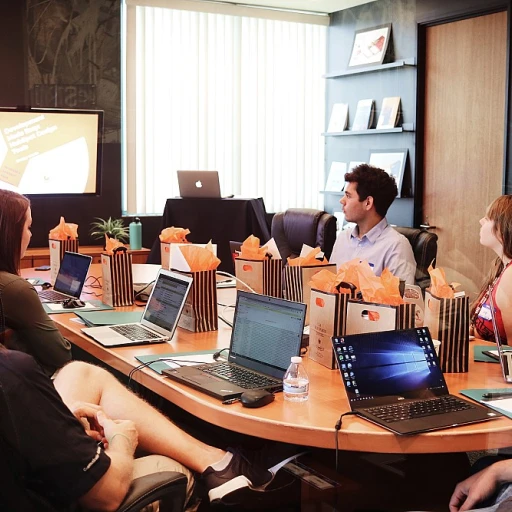
The Role of Role-Playing in HR Innovation
Understanding the Impact of Role-Playing in Human Resources
Role-playing, widely associated with training in customer service and sales, is steadily gaining traction as a tool for innovation in human resources. It serves to build a deeper understanding of the company’s culture, values, and operational nuances, contributing to a more cohesive and high-performing workforce. In the evolving landscape of digital business models, companies are increasingly recognizing the need for unique approaches like role-playing. As streaming giants like Netflix focus on creating original content and optimizing user experiences, their innovative culture extends beyond their primary business functions into the realm of HR. At the forefront of this change is the integration of role-playing to simulate realistic scenarios employees may face, fostering innovation and enhancing decision-making skills. Role-playing in HR is not simply about enacting predefined roles; it revolves around instilling a sense of freedom and responsibility among employees. This mirrors Netflix’s own "freedom and responsibility" approach, as seen in their renowned culture deck. It empowers employees by providing them the latitude to experiment and learn from scenarios reminiscent of real-world challenges. Such exposure is instrumental in cultivating a culture of innovation and creativity that is crucial for sustained growth. Netflix's approach is a testament to how role-playing can facilitate the development of high-performance teams. Learning through doing, or experiential learning, reinforces values and skills that underpin cohesive company culture. This dynamic form of training can be particularly effective in a company where quick decision-making and adaptability to change are paramount. As we delve deeper into Netflix's practices and their outcomes, we'll explore the distinctive ways they utilize role-playing. This will shed light on broader benefits, challenges, and future trends impacting HR innovation. The journey of exploring Netflix's innovative culture begins by understanding the critical role role-playing plays in shaping a robust HR strategy.Netflix's Unique Approach to Role-Playing
Netflix's Strategy to Role-Playing for HR Advancement
Netflix has always been at the forefront of innovation, not just in streaming and entertainment, but also in its approach to human resources. The company's unique way of using role-playing to drive HR innovation is a clear reflection of its culture of freedom and responsibility. This strategy aligns with Netflix's overall business model, which emphasizes original content and high performance. In the Netflix culture, employees are given significant freedom to push boundaries, and role-playing is central to this. It allows team members to navigate complex scenarios by immersing themselves in live, interactive simulations. This is not just a novel approach but a practical one that A/B tests decisions in real-time, similar to how Netflix tests content engagement on its platform using data-driven insights. The company's role-playing exercises are often designed to mirror challenges they might face either in customer service scenarios or in content creation. For instance, discussions about reckless decision making in a 'House of Cards' production setting might help employees understand the impact of creative decisions. This approach ensures that employees, whether they're managing digital user interfaces or developing original series like 'Stranger Things', are prepared for high-stakes environments. Role-playing also fosters a high performing environment by promoting accountability. By reenacting various business situations, employees get immediate feedback, much like Netflix's algorithm provides user-based data insights. Here, machine learning parallels are evident, as continuous learning remains at the core of both technologies and workplace strategies. Ultimately, Netflix's role-playing methods illustrate how its culture deck transcends mere content strategies; it becomes a powerful HR innovation tool. While freedom and responsibility are central, so is the preparation for real-world challenges, which enhances Netflix's stature as a leader in both entertainment and workplace innovation.Benefits of Role-Playing in the Workplace
Unlocking Workplace Creativity with Innovative Techniques
Netflix is renowned for its progressive company culture, including its unique approach to role-playing, which plays a pivotal role in driving HR innovation. This approach significantly contributes to fostering creativity and teamwork among employees, setting Netflix apart in the competitive streaming industry. Role-playing can transform the workplace by creating dynamic scenarios that encourage employees to explore various perspectives. This technique aligns with Netflix's 'freedom and responsibility' philosophy, promoting an environment where employees can experiment with decision-making processes without fear of failure. By simulating different situations, employees gain a deeper understanding of potential outcomes and how their roles impact the broader business model. Moreover, with the help of role-playing, employees can engage in strategic discussions about Netflix’s original content creation. Through role-playing, employees can consider various data-driven strategies, enhancing their analytical skills and improving the company's digital and content offerings. This aligns with Netflix's ongoing commitment to content innovation evident in beloved series like 'Stranger Things' and 'House of Cards'. Netflix encourages high-performance and high-performing teams through these exercises, reflecting their dedication to maintaining their entertainment industry's leading edge. Benefits of role-playing in this context include the development of a proactive and engaged workforce, equipped to tackle challenges with inventive solutions. Employees learn to integrate feedback effectively, refine their problem-solving skills, and improve their ability to predict and respond to user and customer needs. Furthermore, role-playing fosters a culture of trust and collaboration, crucial elements within the Netflix innovation ecosystem. As more companies integrate similar methodologies, the potential for transformative business practices in human resource departments worldwide increases, driving the evolution of company cultures towards a more flexible, inclusive future.Challenges and Considerations
Overcoming Challenges and Leveraging Opportunities
The implementation of role-playing techniques in an organization requires strategic planning and careful consideration of various factors, ensuring alignment with the company’s larger operations and culture, such as Netflix’s renowned "freedom and responsibility" culture. To effectively integrate such practices, companies must navigate through certain challenges while leveraging the opportunities they present to drive HR innovation.
One key challenge involves maintaining the balance between structured role-playing scenarios and the freedom that Netflix culture is built upon. While role-playing encourages creativity and innovation, it must be adapted to respect each employee’s individual work style, especially in a high-performance environment. Companies like Netflix benefit from leveraging their extensive data resources, machine learning insights, and feedback loops to customize role-playing scenarios, ensuring relevance and engagement for each participant.
Additionally, streaming platforms like Netflix must consider the digital nature of their operations. This digital focus means that role-playing activities should align with their business model. Whether it involves reenacting customer interactions or exploring scenarios related to content decisions like those in "Stranger Things" or "House of Cards," ensuring that role-playing is a meaningful part of the decision-making process is key.
- Aligning with Company Goals: Ensuring that role-playing exercises align with the company’s content strategy and brand guidelines can reinforce employee understanding of business objectives.
- Integration with Technology: Leveraging artificial intelligence and digital tools to simulate real-world scenarios can enhance the realism and effectiveness of role-playing activities.
- Feedback and Adaptation: Continuous collection of employee feedback and adapting sessions based on that feedback helps in optimizing outcomes.
Finally, a critical consideration in the implementation of role-playing at a company like Netflix involves the integration of its core cultural elements. Understanding the Netflix culture deck and the philosophy of "freedom and responsibility" allows role-playing scenarios to be naturally woven into the organizational fabric, enhancing employee satisfaction and contributing to the company’s overall success in creating compelling original content.












